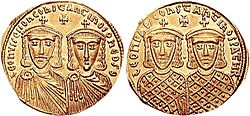Byzantine Empire under the Isaurian dynasty
| Byzantine Empire | ||||||||||
| Βασιλεία Ῥωμαίων | ||||||||||
|
||||||||||
| Capital | Constantinople | |||||||||
| Languages | Greek | |||||||||
| Government | ||||||||||
| Emperor | ||||||||||
| • | 717–741 | Leo III the Isaurian | ||||||||
| • | 741–775 | Constantine V | ||||||||
| • | 775–780 | Leo IV | ||||||||
| • | 780–797 | Constantine VI (under his mother Irene's rule as Empress regent) | ||||||||
| • | 797–802 | Irene of Athens | ||||||||
| History | ||||||||||
| • | accession of Leo III the Isaurian | 717 | ||||||||
| • | deposition of Irene of Athens | 802 | ||||||||
|
||||||||||
The Byzantine Empire was ruled by the Isaurian or Syrian dynasty from 717 to 802. The Isaurian emperors were successful in defending and consolidating the Empire against the Caliphate after the onslaught of the early Muslim conquests, but were less successful in Europe, where they suffered setbacks against the Bulgars, had to give up the Exarchate of Ravenna, and lost influence over Italy and the Papacy to the growing power of the Franks.
The Isaurian dynasty is chiefly associated with Byzantine Iconoclasm, an attempt to restore divine favour by purifying the Christian faith from excessive adoration of icons, which resulted in considerable internal turmoil.
By the end of the Isaurian dynasty in 802, the Byzantines were continuing to fight the Arabs and the Bulgars for their very existence, with matters made more complicated when Pope Leo III crowned Charlemagne Imperator Romanorum ("Emperor of the Romans") which was seen as making the Carolingian Empire the successor to the Roman Empire or at least the western half.
The Heraclian dynasty (610–695 and 705–711) faced some of the greatest challenges in history. After successfully overcoming the Sassanid Persians, the Emperor Heraclius (r. 610–641) and his exhausted realm were faced with the sudden onset of the Muslim expansion from Arabia into the Levant.
...
Wikipedia

